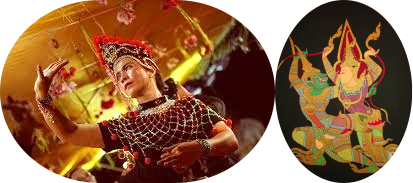The students are divided into three groups, based on the characters in the mythical story which inspires this drama dance, and each of them is under the supervision of one master. The first group, who play as monkey soldiers, have to jump and roll around and fight with wooden daggers.
The second group, the yak or ogre warriors, have been trained to dance gracefully while using long rods as weapon props. The last group, called neay rong, is made up of important characters in the epic, including white monkey king Hanuman, Preah Ream (Rama), Preah Leak (Lakshmana, also known as Rama’s younger brother) Seda (Sita), Krong Reap (Ravana), and so on.
“As a rule, each student’s physique has to be examined before deciding on which role they play,” says Heng Sao, who at 72 is the oldest master of Lakhon Khol Wat Svay Andet Troupe.
“The ones who perform the role as monkeys have to be small in size and fast while the ogre performers have to be tall and have very flexible bodies.”
While art historians believed that Lakhon Khol has been performed since the Angkor period (802 AD-1431 AD), Sao says Lakhon Khol has been the “soul and identity” of the communities that surround Wat Svay Andet Pagoda for generations – so long that nothing has been known about its origin.

Sao explains that Lakhon Khol Wat Svay Andet contains some postures which do not exist in either contemporary Lakhon Khol, which is performed in Phnom Penh and other parts of Cambodia, or in the similar Khon theatre of Thailand. Another difference, he says, is that the dancers in the roles of Preah Ream and Preak Leak wear crowns instead of masks.
“Lakhon Khol Wat Svay Andet is the most original form of the drama dance and thus represents Lakhon Khol all over the country, although it is being taught only at Wat Svay Andet pagoda today,” Sao says. “Before 1975, Lakhon Khol was not taught only at the pagoda but also in the families.
“I learned it from my father, who learned it from my grandfather. Almost all men and boys in villages around here knew it.”
When Khmer Rouge came into power in 1975 and started ruling the country ruthlessly, a calamity was brought upon Lakhon Khol Wat Svay Andet, just like all other forms of art at that time. Most of the masters and artists were considered enemies of the “revolution” and were killed by Khmer Rouge cadres or died from starvation, diseases and forced labour. During this “dark age”, Wat Svay Andet pagoda, where Lakhon Khol had been practised for hundreds of years, was turned into a Khmer Rouge prison and an execution site.
After the fall of Khmer Rouge in 1979, seven surviving masters and a few artists restored the pagoda as the heart of their art-loving community and resume their teaching to revive their signature drama dance. One of the main purposes behind the revival was to resume and continue giving the annual Lakhon Khol performance at the pagoda on the first Saturday after Khmer New Year, a tradition that has been carried on by the community for centuries. It has been believed to bring happiness and good fortune to the people, who really needed it at that time after four years of unbearable suffering.
According to khmertimeskh.com











